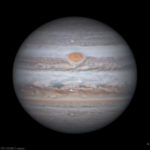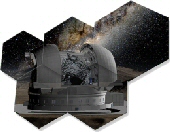Italian (for English please read further down):
Ad un anno dalla mia ultima ripresa riguardante il pianeta Giove, il gigante del nostro sistema solare, rieccomi tornato con una immagine del 13 aprile, 5 giorni dopo il giorno della sua opposizione al Sole – il punto di massimo avvicinamento alla Terra – , ed in condizioni di “seeing” quasi discrete almeno nella banda intorno a 600 nm (canale Rosso).
La Grande Macchia Rossa, la tempesta anticiclonica più conosciuta nel sistema solare, transita al meridiano centrale del pianeta; essa appare un po risolta al suo interno ed inserita nella sua tipica “baia” scavata nella componente sud della SEB (South Equatorial Belt). Nel corso degli ultimi anni il suo diamentro, già in diminuzione dalla fine del secolo scorso, è andato sempre più a diminuire tanto che nel 2014 il diametro massimo della Macchia Rossa è sceso a 16.500 km, il valore più piccolo mai misurato dagli astronomi (fonte wikipedia).
Il dettaglio chiamato dagli addetti ai lavori “STB ghost”, ha da poco passato il suo massimo avvicinamento dalla Grande Macchia Rossa (GRS), risultando sempre più stirato in longitudine.
Una macchia ovale bianca (White Oval Spot), situata ancora più a sud del citato STB ghost (in questa immagine il sud è in alto), ha anch’essa superato in longitudine la GRS.
La NEB, sempre molto attiva, non si smentisce mostrando un insieme di dettagli molto evidenti; dettagli comunque ben visibili anche salendo lungo la latitudine Nord del pianeta.
Mi auguro di tornare presto ad una ripresa gioviana, benché le condizioni del famigerato “seeing”, dalle mie parti e soprattutto negli utlimi anni, siano quasi sempre infelici.
Comunque, grazie per la Vs. cortese attenzione e …. ad maiora semper…. 😉
Dettagli tecnici:
Celestron C14 StarBright ad F/27 – Baader-Zeiss barlow lens – Baader RGB filter set – PointGrey GS3-U3-32S4M-C camera – Seeing 6,5/10 in
R band – sito: Palermo centro @ my personal Observatory
English:
A year after my last shot on Jupiter, here I am back with a picture of the April 13, after 5 days from the time of his opposition to the Sun – the closest approach to the Earth – and in fair seeing conditions, at least in the band around 600 nm (Red channel).
The Great Red Spot, the anticyclonic storm better known in the solar system, is about to the central meridian; it looks enough resolved inside and inserted in its typical “bay” hollowed into the south component of SEB (South Equatorial Belt). In recent years its diameter, already in decline since the end of the last century, it went more and more to decrease, so much that in 2014 the maximum diameter of the Red Spot has dropped to about 16,500 kilometers, the lowest value ever measured by astronomers (source wikipedia).
The detail called “STB ghost,” has just passed its closest approach since the Great Red Spot (GRS), making it increasingly stretched in longitude.
A white oval spot (WOS), located further south of the aforementioned ghost STB (in this image South is up), has also exceeded the GRS longitude.
The NEB, always very active, not denied showing a set of very clearly details; details visible however also going up along the North latitude of the planet.
I hope to return soon to a Jovian imaging, although the conditions of the “seeing”, in my part and especially in the last few years, are almost always unhappy.
However …. ad maiora semper …. 😉
Technical details:
Celestron C14 StarBright to F / 27 – Baader-Zeiss Barlow lens – Baader RGB filter set – PointGrey GS3-U3-32S4M-C camera – Seeing 6.5 / 10 in
R band – website: Palermo city @ my personal Observatory


